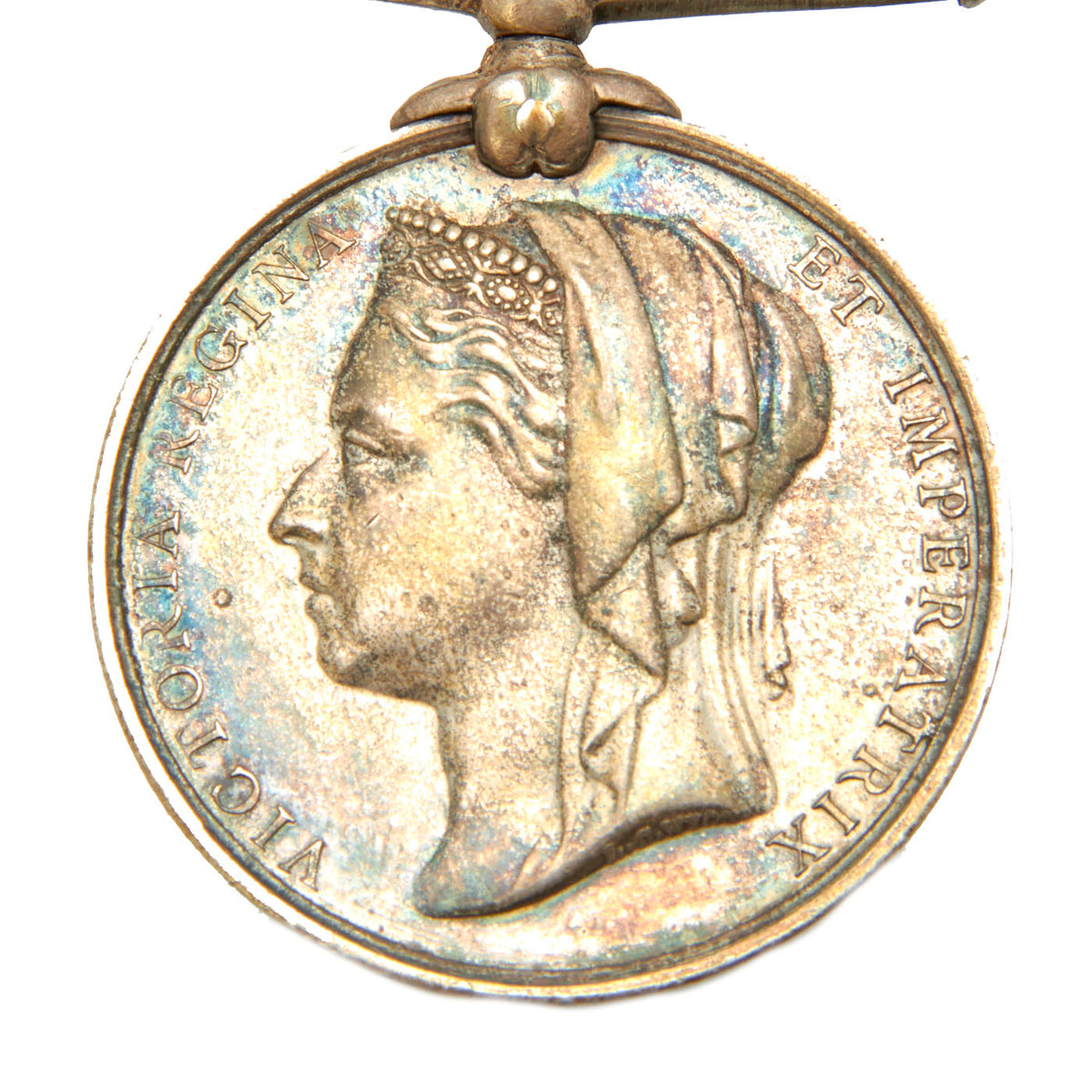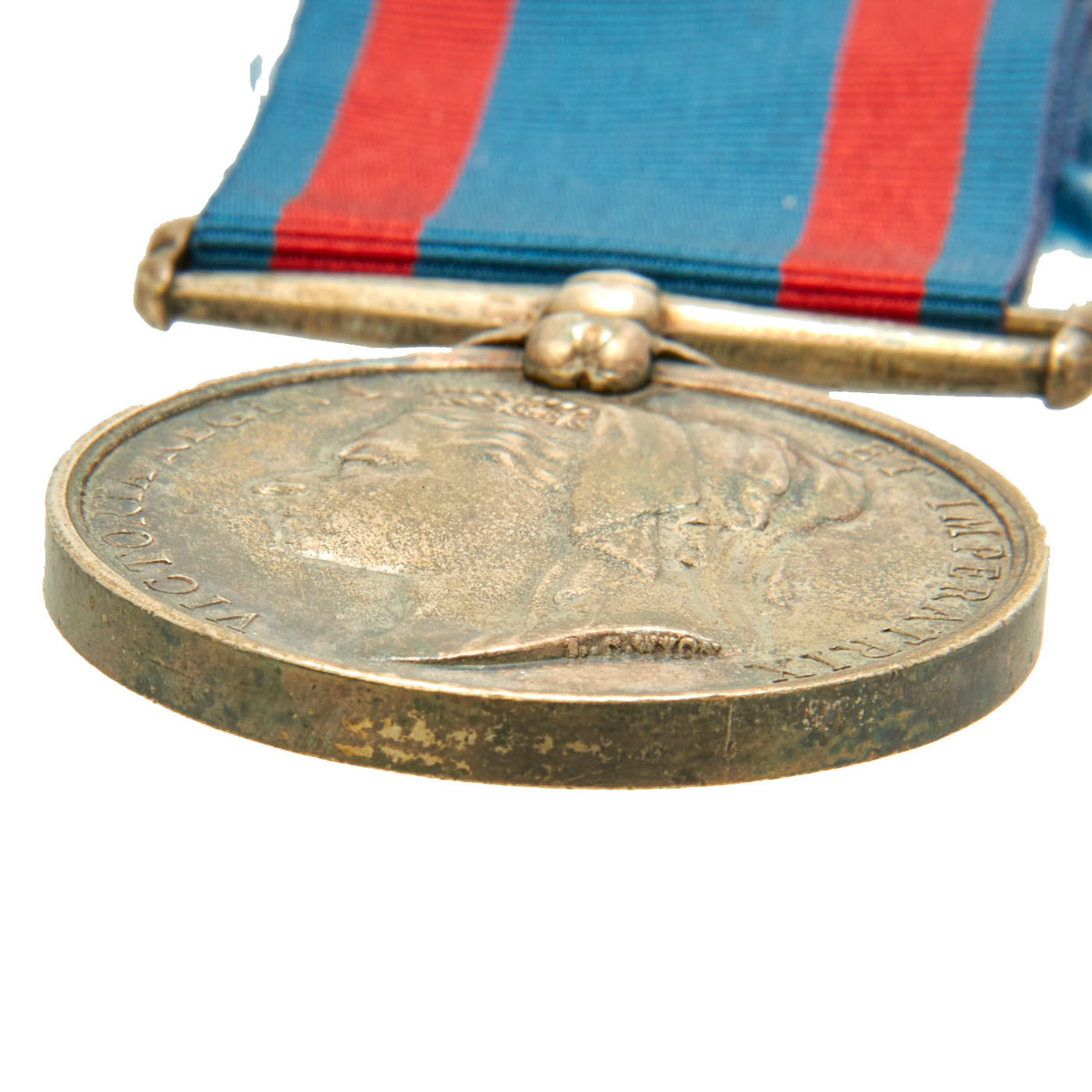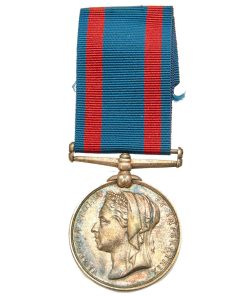Original British 1885 North West Canada Medal Original Items
$ 795,00 $ 238,50
Original Item: Only One Available. The North West Canada Medal is a British campaign medal issued to the soldiers, volunteers, and North-West Mounted Police (NWMP) personnel who participated in putting down the North-West Rebellion in 1885.
The medal is circular, silver and 36 millimeters (1.4 in) in diameter. The obverse, designed by Leonard Charles Wyon, bears an effigy of Queen Victoria, facing left and wearing a diadem and veil. Around the edge is the inscription “VICTORIA REGINA ET IMPERATRIX” which translates to “ Victory Queen and Empress”. The reverse, designed by Thomas Brock, has the inscription “NORTH WEST 1885 CANADA” in three lines surrounded by a wreath of maple leaves.
The medal is suspended from a ribbon in light blue with scarlet red, which is correct for the medal. Medals were issued unnamed, although many recipients had their name and unit engraved on the rim. This one unfortunately is not named or engraved.
The overall condition of the medal and ribbon is incredible given how old the award is. There is no damage or staining to the ribbon and the medal only shows a minor amount of aged patina, still shining bright like it did all those years ago.
A welcome addition to any Pre WWI collection, especially Canadian related ones. Comes ready to display!
The medal was established by the Canadian government in September 1885 after consultation between the governor general of Canada and the British secretary of state for the colonies.
It was awarded to those who took part in the suppression of the North-West Rebellion of 1885 and who served west of Port Arthur, Ontario. Recipients included a number of volunteers, including the crew of the steamer Northcote for service at the Battle of Batoche, and members of the Prince Albert Volunteers for service at the Battle of Duck Lake. Initially, members of the NWMP were not eligible. However, a Canadian order in council of 13 December 1886 recommended that the NWMP receive the medal, this being accepted by the British government on 16 February 1887. A total of 920 medals were then awarded to the NWMP. No British Army units took part, although seventeen British Army officers were attached to Canadian units.
All those who received the medal, except for members of the NWMP, also received a grant of 320 acres (130 ha) of land, or scrip of $80 in lieu. During the 1930s, surviving NWMP recipients were each granted $300.
The North-West Rebellion of 1885 was a rebellion by the Métis people under Louis Riel and an associated uprising by First Nations Cree and Assiniboine of the District of Saskatchewan against the Canadian government. Many Métis felt that Canada was not protecting their rights, their land, and their survival as a distinct people.
Riel had been invited to lead the movement of protest. He turned it into a military action with a heavily religious tone. That alienated Catholic clergy, whites, most Indigenous tribes, and some Métis, but he had the allegiance of 200 armed Métis, a smaller number of other Indigenous warriors, and at least one white man at Batoche in May 1885, who confronted 900 Canadian militia and some armed local residents. About 91 people would die in the fighting that occurred that spring before the rebellion’s collapse.
Despite some notable early victories at Duck Lake, Fish Creek, and Cut Knife, the rebellion was quashed when overwhelming government forces and a critical shortage of supplies brought about the Métis’ defeat in the four-day Battle of Batoche. The remaining Aboriginal allies scattered. Several chiefs were captured, and some served prison time. Eight men were hanged in Canada’s largest mass hanging, for murders performed outside the military conflict.
Riel was captured, put on trial, and convicted of treason. Despite many pleas across Canada for clemency, he was hanged. Riel became a heroic martyr to Francophone Canada. That was one cause for the rise of ethnic tensions into a deep division, whose repercussions continue to be felt. The rebellion’s suppression contributed to the present reality of the Prairie Provinces being controlled by English speakers, who allowed only a very limited francophone presence, and helped cause the alienation of French Canadians, who were embittered by the repression of their countrymen. The key role that the Canadian Pacific Railway played in transporting troops caused support by the Conservative government to increase, and Parliament authorized funds to complete the country’s first transcontinental railway.
Fast Shipping with Professional Packaging
Thanks to our longstanding association with UPS FedEx DHL, and other major international carriers, we are able to provide a range of shipping options. Our warehouse staff is expertly trained and will wrap your products according to our exact and precise specifications. Prior to shipping, your goods will be thoroughly examined and securely secured. We ship to thousands clients each day across multiple countries. This shows how we're dedicated to be the largest retailer on the internet. Warehouses and distribution centres can be located throughout Europe as well as the USA.
Note: Orders with more than one item will be assigned a processing date depending on the item.
Before shipping before shipping, we'll conduct a thorough inspection of the items you have ordered. Today, the majority of orders will be delivered within 48 hours. The delivery time will be between 3-7 days.
Returns
The stock is dynamic and we cannot completely manage it because multiple stakeholders are involved, including our factory and warehouse. So the actual stock may alter at any time. It's possible that you may not receive your order once the order has been made.
Our policy is valid for a period of 30 days. If you don't receive the product within 30 days, we are not able to issue a refund or an exchange.
You can only return an item if it is unused and in the same state as the day you received it. You must have the item in its original packaging.
Related products
Uncategorized
Uncategorized
Uncategorized
Uncategorized
Uncategorized
Uncategorized
Uncategorized
Armoured Fighting Vehicles of the World: AFVs of World War One (Hardcover Book) New Made Items
Uncategorized
Uncategorized
Uncategorized
Uncategorized
Uncategorized
Armored Burgonet Helmet & Polearm from Scottish Castle Leith Hall Circa 1700 Original Items
Uncategorized
Uncategorized
Uncategorized
Angolan Rebel 1970s era 60mm Inert Display Mortar from Angolan Civil War Original Items










































































